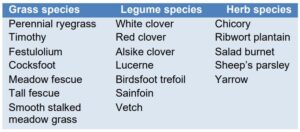Agribusiness News June 2023 – Inputs: Grassland
2 June 2023Why consider mixed species swards?
Mixed species swards (MSS), often called herbal leys, are becoming increasingly popular with livestock farmers. They typically contain a number of species of grasses, legumes and herbs and have many benefits over traditional perennial ryegrass/clover swards. As our changing climate and drier summers have made it more challenging to manage grass in recent years, it is worth considering these more diverse leys and the benefits they can bring to livestock, soil health and the environment.
The following table shows the various species that can be included in a MSS:

While many farmers will be familiar with the higher protein and nitrogen fertiliser saving benefits of red and white clover, other legumes such as sainfoin and birdsfoot trefoil have natural anthelmintic properties, potentially reducing wormer usage (this also applies to chicory). Lambs grazing MSS have been shown to use up to 50% less wormer inputs.
Other benefits of MSS over perennial ryegrass swards include:
- Deep rooting so are more drought tolerant (good examples are plantain, chicory and yarrow which have a strong tap root). Also improves soil aeration and drainage. Water can percolate into the soil more easily, so there is less run-off.
- Carbon capture, carbon is sequestered deeper into the soil, allowing a longer-term accumulation of carbon and organic matter.
- More even growth, with less of a growth surge in May and more growth in late summer, giving an opportunity to extend the grazing season.
- Similar dry matter yields but with significantly less nitrogen fertiliser requirement.
- Improved animal performance, with higher growth rates and lambs reaching slaughter weight on average two weeks earlier.
- Higher mineral content, which may reduce supplementation requirements or improve animal performance.
- Supports pollinators, as flowering species provide a food source for butterflies and bees.
Given the wide range of species available, take advice from your seed supplier on what would be the most appropriate mix for your system, soil type and climate. Is the sward to be used primarily for grazing or silage? Also, what would you like to achieve i.e., higher protein silage, drought resistance, reduced N fertiliser requirements, better soil structure etc? The more functions you want from a MSS, the more species that should be included.
Tips on managing MSS for grazing
- During the first year after establishment, light grazing will help control weeds and encourage tillering to increase sward density. Do not graze too early – allow good leaf cover to build up, helping strengthen root development and persistency. Ideally wait until there are six leaves on plantain and seven on chicory before grazing.
- Rotational grazing is recommended as persistency will be better when the sward has a rest period (around 7-10 days longer than the rest period for a perennial ryegrass ley). Continuous grazing will reduce persistency of legumes and herbs and encourage preferential grazing of certain species (i.e., clover).
- Avoid overgrazing and leave a minimum residual of 6cm. The optimum grazing height is around 3,200kg DM/ha – slightly higher than traditional grass leys.
- Be careful when grazing during wet periods. Poaching can damage herbs so manage grazing in the shoulders of the grazing season to limit sward damage.
Tips on managing MSS for silage
- Include species that can withstand regular cutting i.e., red clover, lucerne (best on high pH sandy soils), and plantain.
- Chicory has a tough stem which can pierce silage bale wrap and goes to head quickly, so it is more suited to grazing.
- Include species with similar growth rates so that slower growing species are not out-competed and shaded by faster-growing ones.
In order to gain maximum benefit of nitrogen fixation, root growth and forage yields, MSS should be down for at least four years. As their cost will be greater than ryegrass/clover mixes, the longer they can be maintained, the better the financial return.
For more information see:
https://www.fas.scot/downloads/grassland-and-herbal-leys-species-guide/
Sign up to the FAS newsletter
Receive updates on news, events and publications from Scotland’s Farm Advisory Service

